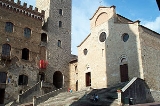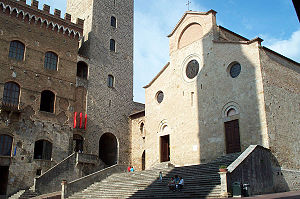
Collegiata di San Gimignano
Encyclopedia

San Gimignano
San Gimignano is a small walled medieval hill town in the province of Siena, Tuscany, north-central Italy. It is mainly famous for its medieval architecture, especially its towers, which may be seen from several kilometres outside the town....
, Tuscany
Tuscany
Tuscany is a region in Italy. It has an area of about 23,000 square kilometres and a population of about 3.75 million inhabitants. The regional capital is Florence ....
, central Italy
Italy
Italy , officially the Italian Republic languages]] under the European Charter for Regional or Minority Languages. In each of these, Italy's official name is as follows:;;;;;;;;), is a unitary parliamentary republic in South-Central Europe. To the north it borders France, Switzerland, Austria and...
, situated in the Piazza del Duomo at the town's heart. It was once the Duomo (cathedral
Cathedral
A cathedral is a Christian church that contains the seat of a bishop...
), but since San Gimignano no longer has a bishop
Bishop
A bishop is an ordained or consecrated member of the Christian clergy who is generally entrusted with a position of authority and oversight. Within the Catholic Church, Eastern Orthodox, Oriental Orthodox Churches, in the Assyrian Church of the East, in the Independent Catholic Churches, and in the...
it has reverted to the status of a collegiate church
Collegiate church
In Christianity, a collegiate church is a church where the daily office of worship is maintained by a college of canons; a non-monastic, or "secular" community of clergy, organised as a self-governing corporate body, which may be presided over by a dean or provost...
.
The first church on the site was begun in the 10th century. The present building was begun in the early 12th century and was consecrated by Pope Eugene III
Pope Eugene III
Pope Blessed Eugene III , born Bernardo da Pisa, was Pope from 1145 to 1153. He was the first Cistercian to become Pope.-Early life:...
in 1148. It was altered and enlarged by Giuliano da Maiano
Giuliano da Maiano
Giuliano da Maiano was an Italian architect, intarsia-worker and sculptor, the elder brother of Benedetto da Maiano, with whom he often collaborated.- Biography :...
between 1466 and 1468. The façade dates from 1239 and is remarkably plain.
The Romanesque
Romanesque architecture
Romanesque architecture is an architectural style of Medieval Europe characterised by semi-circular arches. There is no consensus for the beginning date of the Romanesque architecture, with proposals ranging from the 6th to the 10th century. It developed in the 12th century into the Gothic style,...
interior is famous for its lavish fresco
Fresco
Fresco is any of several related mural painting types, executed on plaster on walls or ceilings. The word fresco comes from the Greek word affresca which derives from the Latin word for "fresh". Frescoes first developed in the ancient world and continued to be popular through the Renaissance...
es, which almost entirely cover the walls. The arcades
Arcade (architecture)
An arcade is a succession of arches, each counterthrusting the next, supported by columns or piers or a covered walk enclosed by a line of such arches on one or both sides. In warmer or wet climates, exterior arcades provide shelter for pedestrians....
are of black and white striped marble
Marble
Marble is a metamorphic rock composed of recrystallized carbonate minerals, most commonly calcite or dolomite.Geologists use the term "marble" to refer to metamorphosed limestone; however stonemasons use the term more broadly to encompass unmetamorphosed limestone.Marble is commonly used for...
. In the centre is a large fresco of St Sebastian by Benozzo Gozzoli
Benozzo Gozzoli
Benozzo Gozzoli was an Italian Renaissance painter from Florence. He is best known for a series of murals in the Palazzo Medici-Riccardi depicting festive, vibrant processions with wonderful attention to detail and a pronounced International Gothic influence.-Apprenticeship:He was born Benozzo di...
(1465), commissioned after the plague
Pandemic
A pandemic is an epidemic of infectious disease that is spreading through human populations across a large region; for instance multiple continents, or even worldwide. A widespread endemic disease that is stable in terms of how many people are getting sick from it is not a pandemic...
had hit the town in 1464. A fresco cycle by Taddeo di Bartolo
Taddeo di Bartolo
Taddeo di Bartolo , also known as Taddeo Bartoli, was an Italian painter of the Sienese School during the early Renaissance. He is among the artists profiled in Vasari's Le Vite delle più eccellenti pittori, scultori, ed architettori...
depicts the Last Judgement in gruesome detail. There are also cycles of the Old Testament
Old Testament
The Old Testament, of which Christians hold different views, is a Christian term for the religious writings of ancient Israel held sacred and inspired by Christians which overlaps with the 24-book canon of the Masoretic Text of Judaism...
by Bartolo di Fredi
Bartolo di Fredi
Bartolo di Fredi , sometimes called Bartolo Battiloro, was an Italian painter, born in Siena, classified as a member of the Sienese School....
(1356–1367) and the New Testament
New Testament
The New Testament is the second major division of the Christian biblical canon, the first such division being the much longer Old Testament....
, traditionally attributed to Barna da Siena
Barna da Siena
Barna da Siena, also known as Barna di Siena, was a Sienese painter active from about 1330 to 1350, and was the painter in Siena during this period. He learned his trade from Simone Martini...
(who supposedly died in a fall from the scaffolding while painting them), but possibly by Lippo Memmi
Lippo Memmi
Lippo Memmi was an Italian painter from Siena. He was the foremost follower of Simone Martini, who was his brother-in-law....
(begun in 1333).
The two main chapels are the Cappella di San Gimignano, with an altar by Benedetto da Maiano
Benedetto da Maiano
Benedetto da Maiano was an Italian sculptor of the early Renaissance.Born in the village of Maiano , he started his career as companion of his brother, the architect Giuliano da Maiano. When he reached the age of thirty he started training under the sculptor Antonio Rossellino...
, and the Cappella di Santa Fina, designed by Giuliano da Maiano
Giuliano da Maiano
Giuliano da Maiano was an Italian architect, intarsia-worker and sculptor, the elder brother of Benedetto da Maiano, with whom he often collaborated.- Biography :...
, with the sculpture by his brother Benedetto. Domenico Ghirlandaio
Domenico Ghirlandaio
Domenico Ghirlandaio was an Italian Renaissance painter from Florence. Among his many apprentices was Michelangelo.-Early years:Ghirlandaio's full name is given as Domenico di Tommaso di Currado di Doffo Bigordi...
painted the frescoes in the latter chapel. St Fina was born in San Gimignano in 1238, contracted an incurable disease when she was ten and spent the five years until her death lying on a board to increase her suffering before God. On her death the board was covered in flowers. The house where she supposedly lived and died still stands in the town.

